
views
Understanding the Format

Understand the purpose of an argumentative essay. The purpose of this type of essay is to fully investigate an issue or topic. This involves extensive research covering all aspects of the topic and gathering information on all involved points of view. Argumentative essays also provide your audience with a well-rounded summary of the issue at hand, but clearly indicate what your own point of view is and why this view is the best option over others.

Understand the methodology of an argumentative essay. To prepare yourself to write an argumentative essay, it is crucial for you to fully immerse yourself in the subject material. The effectiveness of this type of essay depends on the author's ability to parse through the various facets of the topic and lead the reader toward an obvious and logical conclusion. To this end, you must familiarize yourself with all opinions about the topic so that you can also outline the viewpoints that oppose your own view (counterarguments).

Understand the desired outcome of an argumentative essay. In the end, one of the main reasons someone chooses to write an argumentative essay (other than the fact that their professor told them to!), is to attempt to sway another person or group of people in their opinion on a subject Make sure you have your desired outcome in mind as you move forward in the writing process.
Selecting a Topic

Choose something that fits the format. Remember that an argumentative essay will argue in support of a particular view in a debatable issue. As such, it is important that you do not choose a topic that is not arguable. For example, writing an argumentative essay on the fact that exercise is good for you would be undesirable because it would be difficult to find contradicting views on the topic; everyone agrees that exercise is good for people.

Pick an issue that is interesting to you. You'll be spending a lot of time researching and writing this paper. So it is important for you to choose a topic that you find interesting from the start. Avoid choosing a topic that has been overdone, or, on the other hand, one that is too obscure (since supporting evidence may be more difficult to find).

Test your argument. Find a peer (preferably one that holds an oppositional view) to discuss your argument with. This process will help you refine your thinking and develop new ideas to support your judgment. Try a debate-style conversation in which you each bring up aspects of the controversy and attempt to explain your view on the topic.

Keep your audience in mind. An important aspect of writing an argumentative essay is understanding your audience. Are you writing the paper for a class, in which case your audience is your professor and your classmates? Or perhaps you are writing it for a presentation to a larger group of people. Regardless, you must think about where your audience is coming from in order to lead them to your desired outcome. People's backgrounds and experiences often influence how they will react to views different from their own, so it is helpful for you to be knowledgeable about these factors. You also use different language when addressing different groups of people. For example, you would speak to the pastor at your church differently than you might speak in a casual setting with your best friend. It is important to be mindful of these distinctions when considering your audience.

Understand the rhetorical situation. It is essential that you understand all of the factors in the situation surrounding your issue. All rhetorical situations contain five basic elements: the text (in your case, the essay), the author (in this case, you), the audience, the purpose or purposes of the communication, and the setting. Rhetorical situations usually involve employing language that is intended to persuade someone toward a particular view or belief. That is why rhetoric is important in an argumentative essay. These types of essays aim to convince the reader that the author's view on the subject is the most correct one.
Structuring Your Argument
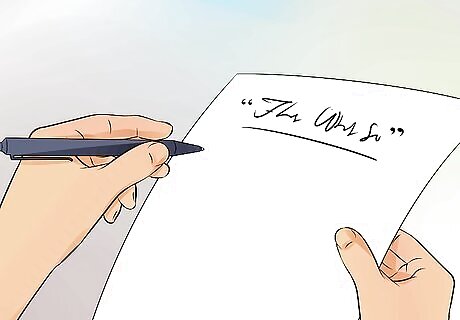
Create a catchy title. Developing a creative, original title is a fantastic opportunity to hook your reader into wanting to read more of your paper before they even get to the introduction. A good title will act as a "preview" for what your paper will be about. Many titles for academic papers come in two parts, separated by a colon. The first part is often a catchy hook that involves a pun on your topic or an impactful quote, and the second part is usually a sentence that sums up or provides details about your argument.
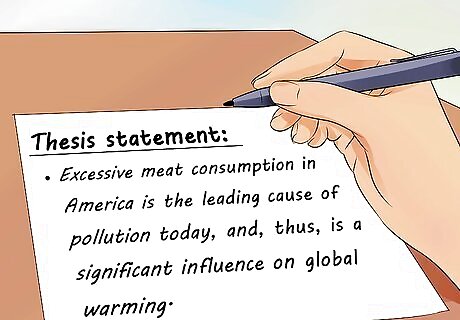
Come up with a thesis statement. Your thesis statement will be a concise idea that sums up your view on the issue. The thesis usually appears at the end of the introduction paragraph. Having this idea in mind early on in the reading process will help guide your reader through the rest of the paper. A good thesis statement is concise and clear. It tells the reader what the point of the paper is and why it's important. The thesis must make a claim of some sort. This can be a claim of value (describing the worth of how we view a certain thing), a claim of definition (arguing that the way we define a term or idea needs to be altered in some way), a claim of cause and effect (claiming that one event or thing caused another event or thing), or a claim about policy solutions (arguing that the way we do things needs to be changed for some reason). Here is an example of a strong thesis statement: Excessive meat consumption in America is the leading cause of pollution today, and, thus, is a significant influence on global warming. This thesis makes a claim (specifically a cause and effect claim) about a debatable topic with a narrow enough focus to create an interesting, manageable argumentative essay. Here is an example of a weak thesis statement: Pollution is a problem in the world today. This is not a debatable issue; few people would argue that pollution is not a problem. The topic is also too broad. You can't write a paper on every single aspect of pollution.
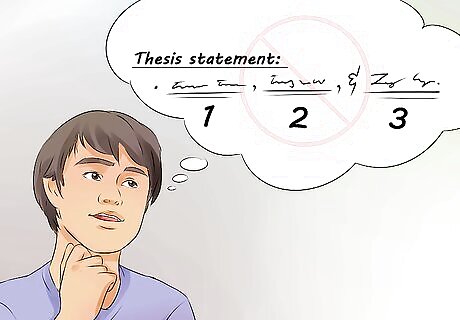
Avoid the standard three-part thesis often taught to beginning writers. This format is constricting and limits the shape your ideas can take to being contained in three basic body paragraphs. Without the three-part thesis statement, your ideas can expand more freely and incorporate ideas that might not fit exactly into the three parts.
Changing the thesis to avoid this form will make for a much more functional essay that is written at a more advanced level. A more effective thesis would be something like this: Due to increasing global temperatures and rising ocean levels, global warming has become an issue that needs to be acknowledged by a wider audience in order to begin reversing the effects.
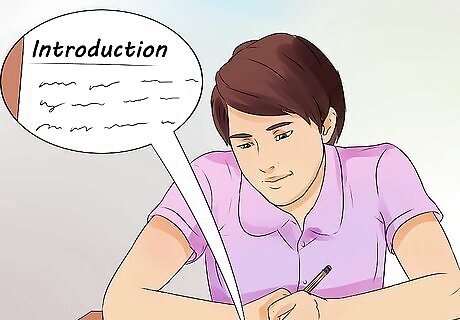
Write an introduction. This section should briefly explain the essay topic and include relevant background information to familiarize the reader with the topic. As previously mentioned, your thesis statement should appear at the end of the introduction.
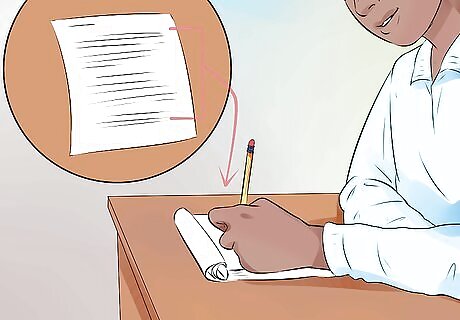
Write the body of the paper. Carefully present information that supports both your argument and opposition. Acknowledge evidence that supports the opposition, but utilize powerful evidence to assert your claim. There are many different ways to organize your argument, but the most important thing is that you cover all aspects of the issue. Leaving out information simply because it contradicts your thesis idea is unethical as it does not provide an accurate portrayal of the issue. Be sure to include counterarguments (those ideas that are at odds with your own view), but explain to your reader why your own viewpoint is more logical and accurate, perhaps because the opposing view is based on outdated information, etc. Avoid implicating opposing views as wrong because it could alienate your readers.
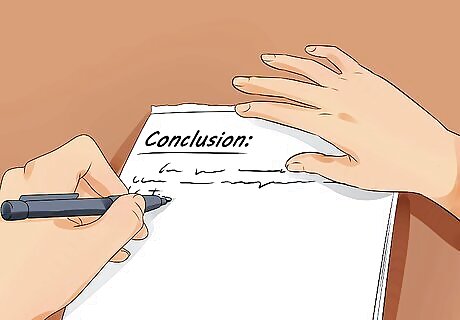
Write a conclusion. The aim of this section is to reassert your argument and persuade the audience to support your claim. Try to connect the essay topic to the interests and values of the audience. Be sure to review your main points and restate your thesis. But make sure not to introduce any new information in the conclusion so that you can effectively wrap up what you've already said. Often, it is helpful to end with a look forward to further research that could be done on the topic in light of what you have said in your paper.
Including Research and Sources

Do your research. Go to the library and look up books on the subject. Or look up information from reliable sources on the internet. It is important to find sources that cover all views of the issue since the point of this kind of essay is to provide a well-rounded overview of all aspects of the topic. Collecting evidence and information that supports both your argument and the opposing view will strengthen your essay. Ask a reference librarian for assistance in finding reputable, useful sources for your argument. They will probably be happy to help you.

Pick sources that are reputable and provide accurate, up-to-date information. The best research acknowledges the foundational work on a given subject, but also interrogates innovations in the field and divergences from the status quo. You do this by looking at sources that are both old (these provide the foundation of the topic) and new (these provide current trends in thought on an issue).

Choose quotes that support your points. In order to make your work more credible, it is important to incorporate quotes from sources that are considered scholarly. Scholarly sources should be written by experts in the field (i.e. use a quote from someone with a PhD in environmental science if you are writing an argumentative paper on the dangers of global warming) or published in scholarly, peer-reviewed outlets. This means that sources are fact-checked by a panel of experts before they are approved for publication. It is important to remember that anyone can write things on the internet without any kind of publication standards for accuracy, so using blogs and many websites is not a good idea in an academic paper.
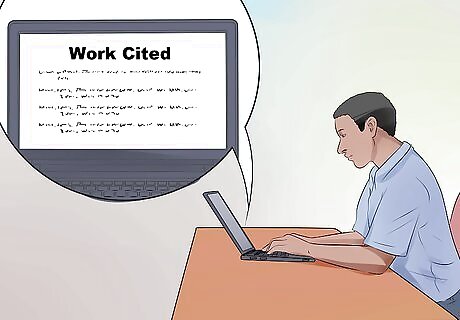
Cite your sources. When you use quotes in a paper, you must cite them properly. If you don't cite your sources, this is a form of plagiarism because you are not giving credit to the people whose ideas you are using in your paper. Citing sources involves writing quotation marks (") around the verbatim quotes and then including a parenthetical in-text citation at the end of the quote that refers to a source listed on the Bibliography or Works Cited page at the end of your paper. There are several different formatting methods that are used in different fields. For example, in English departments they use MLA formatting and in history departments they usually implement Chicago style formatting.
Editing and Applying Final Touches

Take a step back. Often, it's possible to get so wrapped up in your own writing that it's easy to skip over obvious errors and mistakes. Take a break from writing for at least a few hours. Sometimes leaving your work for a couple of days can be incredibly beneficial as well. Looking at your work with fresh eyes will allow you to see the errors you previously overlooked because you were so involved in the writing that you could only see what you meant to say rather than what you actually said.

Look for grammar issues. Problems with grammar can make your paper look sloppy and unprofessional. Here are some of the most common grammar mistakes: Sentence fragments. Fragments are incomplete phrases that cannot stand alone as a sentence because they are missing either a verb, a noun, or a complete thought. Parallelism. Errors in parallelism occur when words or groups of words do not appear in the same format or structure within a sentence. Subject-verb agreement. Errors with subject-verb agreement happen when an incorrect verb form is used with a particular subject. For example, he know instead of he knows.

Check for problems with formatting or quote incorporation. Formatting quotes properly allows your reader to easily find the information you are referencing. It also adds to your credibility as an author.




















Comments
0 comment